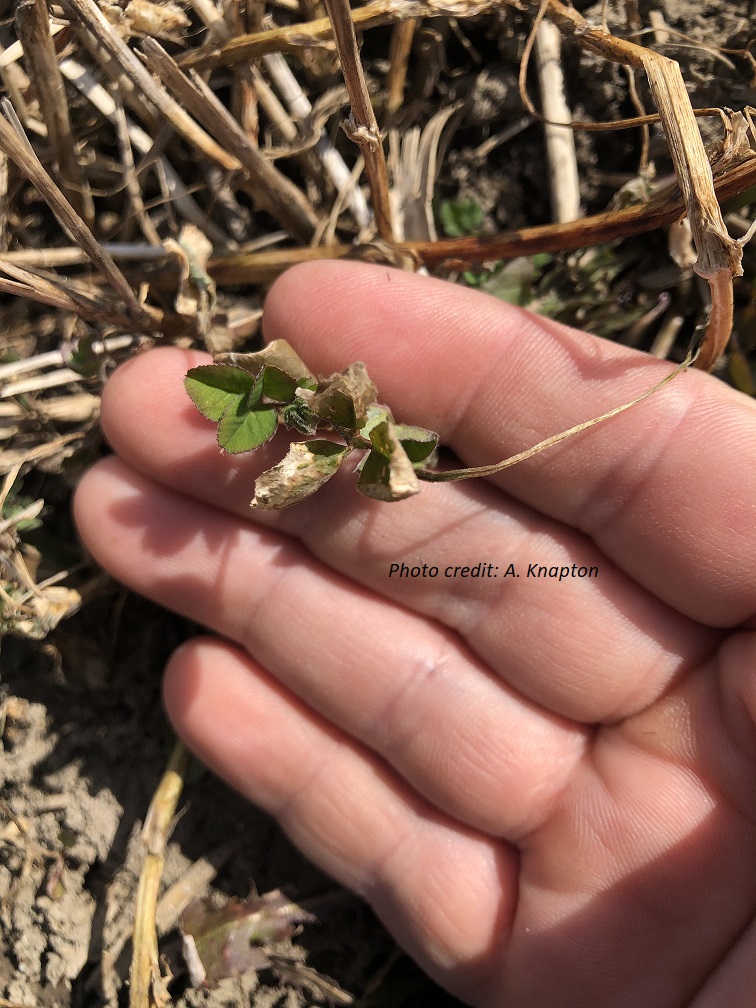Photo: Scouting a few days after a spring frost is a good way to assess the severity of any damage.
Good agronomy is very important for achieving good yield and quality in forage crops. While good agronomy includes a fertility plan, seeding techniques, and harvest management, it also relies on proactive decision-making. The only way to know what is happening in a field before it is too late is to scout. Taking regular walks through hay fields and observing them carefully is important throughout the growing season, however, there are some special things producers should assess when scouting in the early spring.
At green-up
When the crop has broken dormancy and is putting out new buds, it is time to do a plant count and root health assessment to determine how well the alfalfa overwintered. This first scouting is a producer’s early warning system, letting them know if there is a problem before they are even able to start field work. If the lawn is green and the hay field isn’t, that could be a warning sign!
The target number of healthy alfalfa plants per square foot varies depending on the age of the stand. Alfalfa stands thin naturally over time but can compensate because the crown of older plants is larger and sends up more shoots. Table 1 shows how many healthy plants per square foot should be present in the field. Where there are ranges, pure stands should be near the high end, while alfalfa/grass mixtures can be at the low end of the range.
Table 1. Alfalfa plant count guidelines
| Age of stand | # of healthy plants/square foot |
| New seeding | 20+ plants |
| Year 1 | 12-20 plants |
| Year 2 | 8-12 plants |
| Year 3+ | 5 plants |
Plants that have heaved are not healthy. Their crowns are exposed to drying winds, and their tap roots may be broken. These plants will not survive for very long.
Dig up some plants and cut open their roots. Healthy alfalfa taproots are white or cream-coloured, and firm like a potato. Unhealthy roots may be yellow or brown, ropey or stringy, and may smell like rot. Plants with unhealthy roots are unlikely to survive.
If the number of healthy plants per square foot is lower than the targets in Table 1, producers have options and time to put Plan B into action. Fields could be patched with red clover (for protein) or grasses (for yield). Since patched fields should not be kept for another winter, this is a good opportunity to use Italian ryegrass for some very palatable haylage or baleage. Other grasses offer more summer growth. Another option is to terminate the hayfield and rotate it into something else. Alfalfa is autotoxic; it cannot follow itself in a rotation because seedlings will not germinate very well. A new hay field can be seeded someplace else on the farm.
When you have 6 inches of growth
While plant counts will alert producers to a serious problem early in the season, stem counts are a better way to assess the yield potential of alfalfa. Stem counts cannot be done until there is at least 15 cm (6 in.) of growth. Because this is much later in the spring than a plant count, there may be fewer options available to address serious issues.
Each alfalfa plant sends up multiple stems. Table 2 outlines how the number of stems per square foot relates to yield potential.
Table 2. Alfalfa stem count guidelines
| Stems/square foot | % of maximum yield |
| 55+ | 100% |
| 40-50 | 75-92% |
| Less than 40 | Stand is too weak to keep |
Harvest is the most expensive part of growing a hay crop. In addition, there is very little difference in the cost to harvest a low-yielding hay crop or a high-yielding hay crop. This means that a high-yielding hay crop is cheaper to grow per tonne of forage. If the yield potential is less than 75%, it is too expensive to keep harvesting that low yielding crop.
By the time there is enough growth to do a stem count, patching is not an option. The alfalfa will out-compete any new seeds for light and moisture. Most producers in this situation harvest first cut, terminate the stand, and rotate it into something else.
If you get a frost
Many parts of Ontario have had an early spring, and hay fields have broken dormancy and started to grow earlier than usual. A frost may injure the crop, depending on severity and the growth stage of the plant.
Where alfalfa is concerned, temperatures above -3˚C are considered a light frost. Leaves may wilt or develop white spots, and the tops of stems may bend over in a “shepherd’s crook” shape. In general, light frosts do not damage stems or growing points, and normal growth will resume with warmer temperatures.
A heavy frost causes more damage. Temperatures of -4˚C or below for at least four hours can kill stems and growing points. This will delay regrowth, as the plant must start over from the crown or auxiliary buds. Cutting frost damaged alfalfa will not speed up regrowth. If there is enough yield to take for feed, be aware that nitrate concentrations may be elevated in the plant.
Alfalfa seedlings are generally hardy until they reach the second trifoliate stage. Heavy frosts are most risky for seedlings between second trifoliate and the end of contractile growth (where the crown is formed). A few hours of temperatures below -4˚C may kill them. Fortunately, over-seeding with alfalfa is an option to replace a dead seedling stand, as the young plants have not started to release autotoxins yet.
References
Bagg, J. 2013. Spring Frost Damaged Alfalfa. Field Crop News. Available from: https://fieldcropnews.com/2020/04/spring-frost-damaged-alfalfa/
This article was originally published in Ontario Forage Council’s ThinkGREEN! newsletter, Spring 2020.
